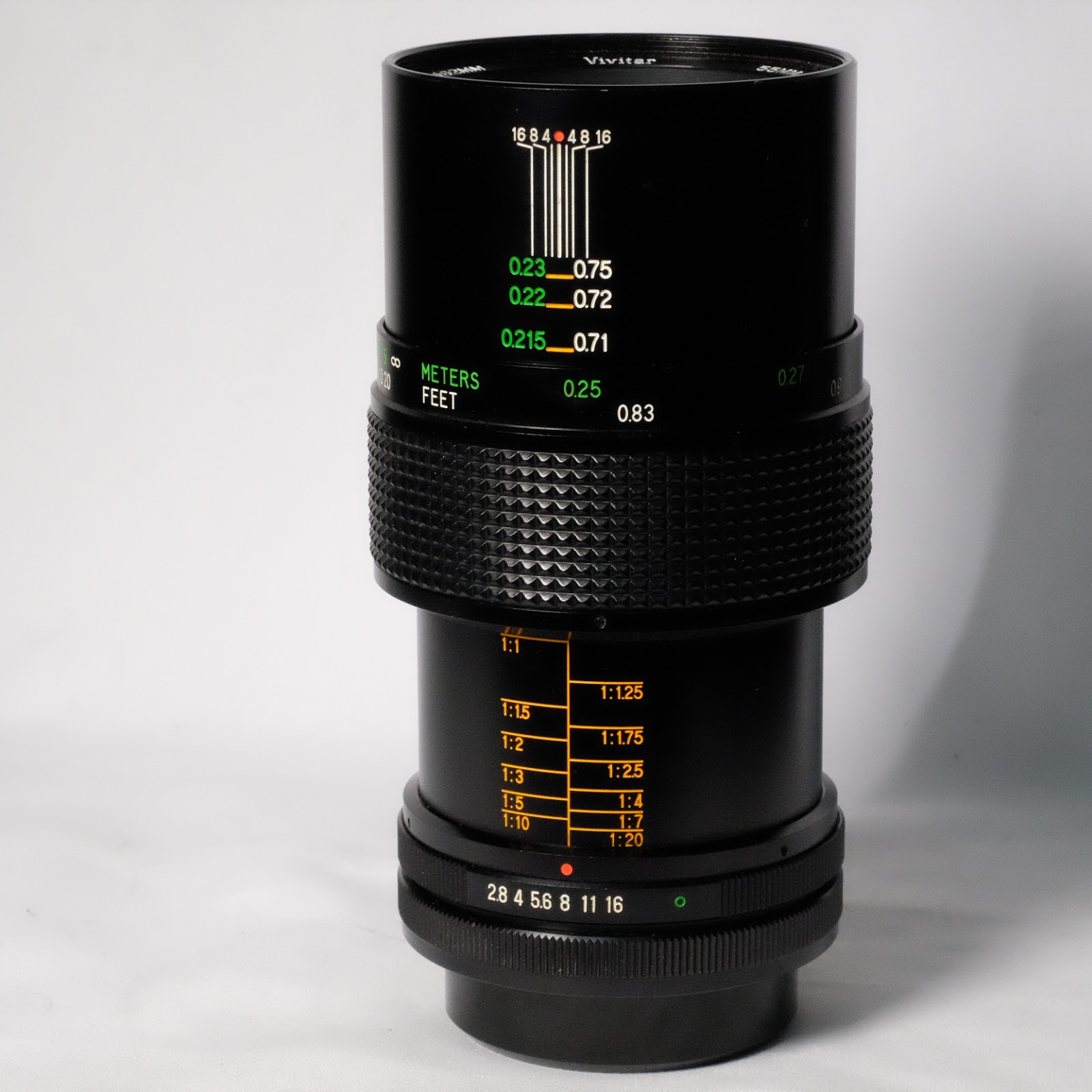This article was originally published in 2019.
Re-written in 24 July 2022
Vivitar MC Macro
55mm f/2.8
Maker - Komine (S/N 28...)
Year - 1970s to mid-1980s
Year - 1970s to mid-1980s
Minimum Focusing - 0.25 meters (1:1)
Filter Thread Ø - 62mm
Aperture Run - f/2.8 - f/16
Optical Formula - 5 elements, 4 groups
Multi-coated elements
Made in Japan
========================================
Impressions
History
1) Asahi Optical introduced the 'SMC (Super-Multi-Coated) Takumar' in 1971. Those were the first ever multicoated lenses introduced to the market. Others followed.
2) Komine, who manufactured respectable lenses for brands like Vivitar, reportedly stopped making lenses for consumers by the mid-1980s.
3) In the mid-1980s (1985), Minolta introduced the first autofocus lenses to the market. The expensive process and patents for making AF lenses led to many third party makers like Komine to stop producing lenses.
4) We can infer from these information that this Vivitar macro lens was made sometime from mid-1970s to mid 1980s.
The Vivitar MC Macro 55mm f/2.8 (Komine) is a cult favorite in the photography community. It was manufactured by Komine and has respectable image quality that can magnify up to 1:1 macro. This is a lens from the 1970s, so its nearest competitor of the time is the Micro-Nikkor 55mm f/2.8 (it only has 1:2 magnification). It's very popular because it goes to 1:1 macro, unlike other macro lenses of the time that only reach 1:2 and require an additional macro extension tube or bellows.
Adaptability
This Vivitar macro lens can be found in common lens mounts of the era -- Nikon F mount, Canon FD, Pentax K, Pentax M42, Minolta SR, Olympus OM, Konica AR (nothing for Minolta/Sony A-mount or Canon EF). Finding this lens in Nikon F mount is rare or never, and I often see it in Canon FD mount. This means that the most likely users of this lens today are mirrorless camera owners.
Build and Handling
This lens is all metal but surprisingly light. The focusing ring is smooth, but it takes one full circle of turn to reach 1:2 (0.25 meters), and another full circle to reach 1:1 (0.215 meters). You need to turn the focusing ring two whole circles to get to 1:1, which can be tiring. The f-stops run from f/2.8 to f/16 only (some macro lenses go down to f/32).
Optical Quality
My copy of this lens was made in 1980, based on the Vivitar serial number guideline. While it claims to be multi-coated, only the front element is MC with green sheen on the glass. All other elements have this amber sheen, indicating single coated elements. The coatings help produce beautiful colors and contrast, and it handles flare very well when the f-stop is wide open at f/2.8. The lens is decently sharp at f/2.8 and very pleasing for shooting portraits with. It magically becomes razor sharp stopped down to f/4.
Alternatives
Summary - Plus:
1) Sharp at f/2.8
2) Good colors, contrast, flare control
3) Stylish and durable build quality
4) 1:1 magnification
Summary - Minus:
1) Focus ring takes two whole circles to get to 1:1
2) Nikon F mount is rare or almost never found in the used market
3) Not all elements are multi-coated
4) Usually found in obsolete mounts that can only be adapted to mirrorless cameras, not for Nikon or Canon DSLRs.
Conclusion
This Vivitar macro lens is a cult classic in the photography community. It's a wonderful gem but usually found in obsolete mounts, which means it is limited to owners of mirrorless cameras. If you own a DSLR, your best bet for macro lens from the same era would be a Micro-Nikkor 55mm f/2.8 or f/3.5. The only one thing that turns me off about this Vivitar lens is the super long focus throw. I prefer the Minolta AF 50mm f/2.8 Macro because it has a shorter focus throw.
 |
| It appears that the front element is multicoated with green sheen. Others may have less layers of coating showing amber colors. |
 |
| My copy in Canon FD mount. |
 |
| The diaphragm has 6 blades. |
 |
| Tiny like a kit lens at infinity. |
 |
| It takes one full circle turn of the focusing ring to get to 1:2 magnification. |
 |
| It takes two full turns of the focusing ring to reach 1:1 as seen here, fully extended. |
 |
| Canon FD mount. |
 |
| Right under the focusing ring, the magnification ratio is etched on the barrel. You don't see modern AF lenses meticulously list these details nowadays. |
 |
| This is in Canon FD mount, adapted to my FUJIFILM X-T10. |
========================================
Samples
Vivitar MC Macro 55mm f/2.8
FUJIFILM X-T10
These JPEGs straight out of camera.
FUJIFILM X-T10
These JPEGs straight out of camera.
 |
| f/16 |
 |
| f/16 |
 |
| At 1:1 |
 |
| f/4 |
 |
| f/2.8 |
 |
| f/2.8 |
 |
| f/2.8 |
 |
| f/2.8 |
 |
| f/2.8 |
 |
| f/2.8 |
 |
| f/2.8 |
 |
| f/2.8 |
Further Reading
# # # E N D # # #






0 comments:
Post a Comment